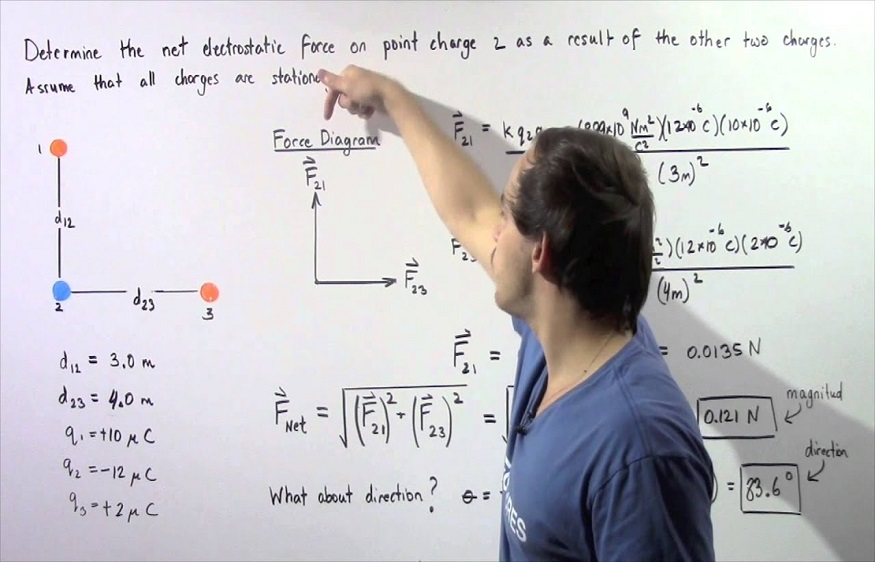The electrostatic force is the force of repulsion or attraction between two electrically charged bodies. It is also known as Coulomb’s interaction or Coulomb’s force. For instance, the attractive force between the electrons and protons in atoms is electrostatic and is predominantly responsible for the stability of atoms. In the case of big and table groups of atoms, the electrostatic bonding force is crucial and holds together ionic molecules.
The electrostatic force among two changed bodies can be calculated by Coulomb’s law. The principle is generally applied to point charges and shows a relation between the charge magnitude and the electrostatic force and separation length. As per this law, the electrostatic force between the two bodies or particles is directly proportional to the multiplication of the charges’ magnitude. It is inversely proportional to the square of the length in between the charges.
Consider that the two charged particles are kept close to one another. For sure, there should be an attraction if the given charges are opposite to one another or if one is negative and the other is positive. In contrast, these charges will repel each other if both of them are either negative or positive. That is, unlike charges attract each other, and like charges repel each. For these points, we can clearly understand that static electricity is the byproduct of an imbalance between positive and negative in an object or body. These charges can accumulate on a body’s surface until they are discharged or released. One method to release them is through an electric circuit.
Rubbing the Rod with Silk Clothes
One generally known example of electrostatic force is rubbing a plastic rod with silk fabric. In most cases, the plastic rod is electrically neutral. When one rubs the rod with silk fabrics, the rod releases a few electrons and transforms into a positively charged object, and the silk cloth gains some electrons to become negatively charged. Therefore, rubbing generates attractive electrostatic force between the silk and the rod.
Nylon Fabrics
Nylon cloths behave as an excellent medium of electrostatic force. When two nylon fabric are rubbed together, one of the fabric gains electrons and become negative, and the other fabric loses electrons and becomes positively charged. One may experience some attractive force while separating the fabrics is surely the electrostatic force arising between the nylon fabrics.
Photocopy Devices
Photocopy devices utilise electrostatic force for recreating the desired pages. The reference page one needs to copy is positioned on the glass, which behaves as the positive charge. Toner behaves as the negatively charged body that attracts the photo that has to be duplicated on the paper sheet, giving the photocopy of the desired page.
Lightning
Lightning is a huge spark of electric discharge in the atmosphere between clouds, the air, or the ground. In the initial stages, air behaves as an insulator between the negative and the positive charges in the clouds and between the ground and the clouds. If the opposite charges accumulate up enough, the insulating ability of the air decreases, and there is a drastic discharge of electric current that is generally known as lightning. This volatile air generates free electrons and ions that flow down the conducting medium. This flow of current temporarily equalises the charged parts in the atmosphere until polar charges accumulate again.
Lightning that is produced from thunderstorms starts in an intense electric field between polar charges with the cloud and could stay entirely within the storm cloud when the charge areas are identical in strength (stable) or can enter the ground when one of the areas is much intenser than the other areas (unbalanced). Lightning is one of the best phenomena that can help us to understand the basics of electrostatics in better detail. Lightning is a natural result of electrostatic interactions. Numerous charges discharge due to lightning, generating rapid motion of the electron in the air.
Comb and Pieces of Paper
A well-known experiment in all school physics syllabi is a plastic comb attracting paper pieces. It is an excellent example of electrostatic force. When the plastic comb is rubbed with oily hair and if we place the comb close to the paper, the lighter paper pieces are attached to the comb surface due to the electrostatic force. When one combs, the hair transmits a few of the electric charges to the plastic comb, acting as a negatively charged object. The pieces of paper behave as the positively charged object and are attracted by the plastic comb, producing electrostatic force between these bodies.
Television Screen
Sometimes, you may see a television screen becoming dusty after a while. What is the reason behind this? Again, the power of electrostatic force comes to play here also. The monitors become dusty due to electrostatic force. These screens are usually positively charged. The positive charges from the screen surface induce and attract dust floating near the screen (the dust particles are considered negatively charged). So, an electrostatic force holds the positive screen and negative dust particles.
Balloons Rubbed with Hair
When two normal balloons are rubbed with our hair and bring them very close together, the two balloons will be attracted to each other and stick together (due to electrostatic force). After a while, the charge produced between the two balloons dies out, causing them to move away from each other.

